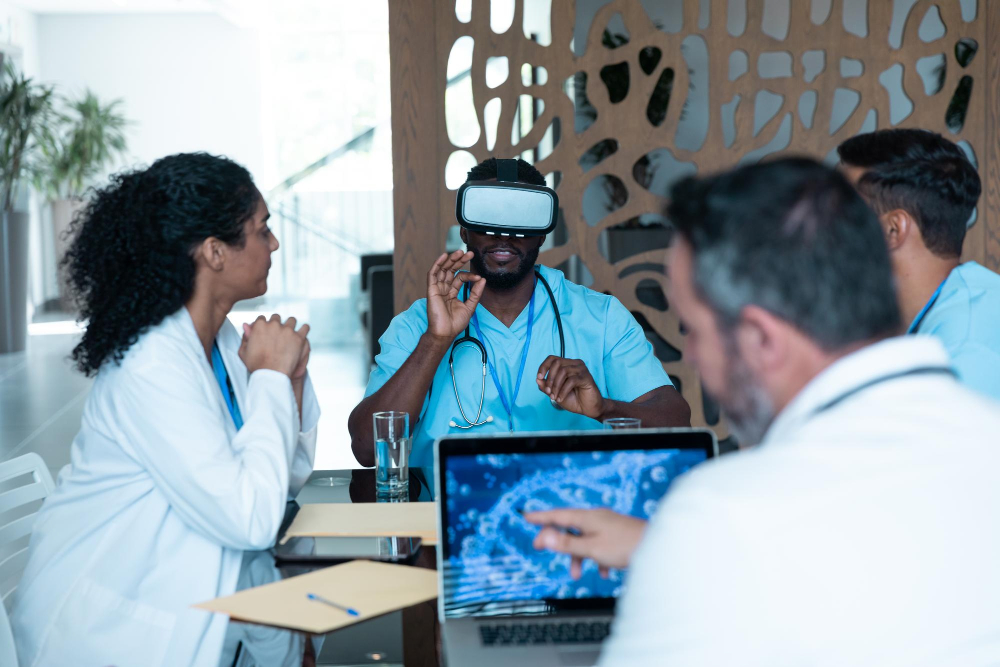
Extended Reality in Healthcare: Applications in Training, Treatment, and Patient Education
XR is a powerful tool that enhances learning for a broad spectrum of healthcare professionals, from surgeons to nurses:
- Surgical Simulations: VR-based surgical simulations provide hands-on practice in a safe, controlled setting, allowing surgeons to hone their skills before performing real procedures. These simulations can mimic complex surgeries, from cardiac to neurological, enabling both novice and experienced surgeons to improve precision and confidence.
- Nurse and Paramedic Training: Nurses and first responders use XR to practice critical care skills in virtual environments that simulate real-life medical emergencies, from triage situations to trauma care. These experiences enhance clinical judgment, decision-making, and procedural skills.
- Anatomy and Procedural Training: Using 3D models, XR allows medical professionals to interact with realistic anatomy, exploring detailed structures and relationships between organs. This is invaluable for medical students, nurses, and physical therapists who rely on a comprehensive understanding of human anatomy.
- Emergency Scenario Simulations: Virtual environments enable entire healthcare teams to practice high-stakes scenarios, such as resuscitations, multi-trauma cases, or outbreaks, strengthening teamwork and preparedness.
Patient Treatment and Rehabilitation
XR is being used to expand the quality of patient treatment and rehabilitation, improving both mental and physical well-being:
- Pain Management with VR Therapy: Patients undergoing painful treatments can use VR to distract from discomfort, particularly beneficial in settings like pediatrics, post-operative recovery, or chronic pain management.
- Mental Health Treatment: XR applications provide controlled environments for exposure therapy, where patients confront phobias or PTSD triggers with professional guidance, especially helpful for trauma recovery and anxiety disorders.
- Physical Rehabilitation through AR-Guided Exercises: Patients recovering from strokes, surgeries, or injuries use AR-guided exercises to track and improve their physical rehabilitation progress, motivated by the visual feedback and progress monitoring.
Patient Education and Empowerment
XR is a dynamic tool for educating patients about their health conditions, treatment options, and care plans:
- Visualizing Conditions and Treatments: Interactive 3D visuals make it easier for healthcare providers to explain medical conditions and procedures to patients, improving their understanding and comfort level.
- Chronic Disease Management and Medication Adherence: AR apps help patients track medication schedules and chronic condition management steps, increasing adherence and improving outcomes.
- Pre-Visit and Procedure Familiarization: Patients can explore virtual tours of healthcare facilities and learn about medical equipment or procedures beforehand, reducing anxiety, especially in pediatrics and mental health care.
Surgical Planning and Execution
XR is aiding surgeons in preparing and performing complex procedures with greater accuracy and insight:
- 3D Modeling for Preoperative Planning: 3D XR models allow surgeons to analyze and plan complex surgeries tailored to individual patient anatomy, which improves surgical accuracy and confidence.
- Real-Time AR Assistance: During procedures, AR can provide real-time visual guidance, highlighting key anatomical landmarks or guiding surgeons in minimally invasive techniques, reducing risks and enhancing precision.
Telemedicine and Remote Care Enhancement
As telemedicine grows, XR adds a new layer of interactivity for remote consultations and emergency guidance:
- VR Consultations: Doctors can conduct VR-based consultations, which create a more immersive experience, helping patients feel more connected and engaged.
- Remote Assistance in Emergencies: AR applications enable experienced practitioners to guide nurses, EMTs, or other medical personnel in real-time, often in critical, remote situations where immediate medical expertise is needed.
Benefits of XR in Healthcare for Medical Teams
- Enhanced Skill Development and Learning: XR simulations enable healthcare professionals to practice intricate procedures, improve teamwork, and gain confidence in high-stakes scenarios without risks.
- Improved Patient Outcomes: XR technology assists in more targeted treatments, accurate procedures, and effective rehabilitation, ultimately leading to better patient outcomes.
- Increased Patient Comfort and Engagement: By visualizing their conditions, patients experience reduced anxiety, better understanding, and greater adherence to treatment plans.
- Cost-Effective and Efficient Training: XR offers realistic training scenarios without the logistical limitations of traditional training models, making it more accessible and cost-effective.
Challenges and Considerations
- Adoption Resistance: Resistance to new technologies among healthcare providers may slow XR implementation, particularly in more traditional settings.
- High Implementation Costs: Initial investments in XR hardware, software, and maintenance may challenge budgets for certain healthcare facilities.
- Data Privacy and Security: XR applications must ensure compliance with stringent data security and patient privacy regulations.
- User Experience Design: XR tools must be user-friendly and comfortable for diverse users to ensure successful integration into care settings.
Case Study: XR-Enhanced Rehabilitation in Stroke Recovery
In one rehabilitation center, nurses implemented VR therapy for stroke patients. The results demonstrated significant improvements:
- 20% Increase in Motor Function Recovery: Patients using VR rehabilitation exercises showed faster and more comprehensive recovery compared to traditional therapy.
- Higher Engagement and Motivation: Patients were more motivated to participate in VR therapy sessions, leading to consistent attendance and better outcomes.
- Pain Reduction and Comfort: Patients reported lower pain levels during VR-based therapy, which also reduced their reliance on pain medications.
Future Trends in XR for Medical Practitioners
- Artificial Intelligence (AI) Integration: AI-powered XR can deliver personalized care, analyzing patient data to tailor experiences and optimize treatment plans.
- Haptic Feedback for Realism: Haptic feedback is being developed to create tactile sensations, enhancing medical simulation realism for surgeons and trainees.
- 5G-Enhanced Real-Time Applications: With the rollout of 5G, XR applications will benefit from high-speed, real-time interactivity, which is especially promising for remote care and consultations.
- Home-Based XR Monitoring and Therapy: XR applications are expected to expand into home-based care, where patients can participate in monitored treatments or therapy exercises remotely, increasing care accessibility.
Conclusion
Extended Reality is redefining the landscape of healthcare by offering powerful tools for training, treatment, and patient education across diverse roles, from surgeons to nurses to therapists. As XR technology continues to evolve, its role in healthcare will become even more integral, equipping healthcare teams with immersive, precise, and engaging resources to improve care delivery and patient outcomes. The future of healthcare is truly being shaped by the groundbreaking possibilities of Extended Reality.
